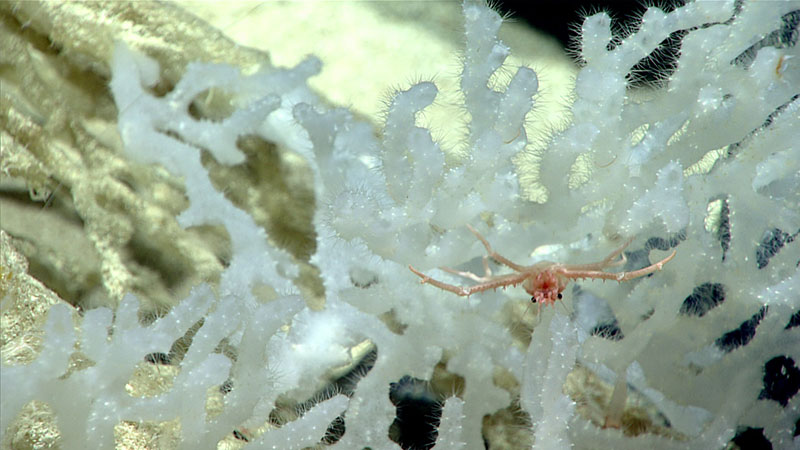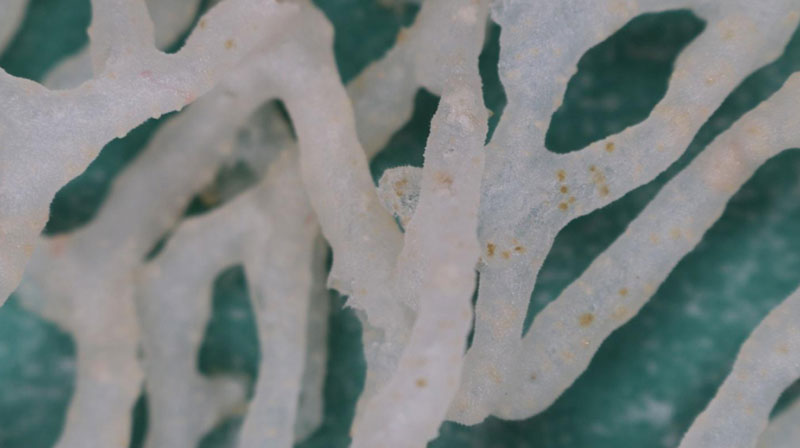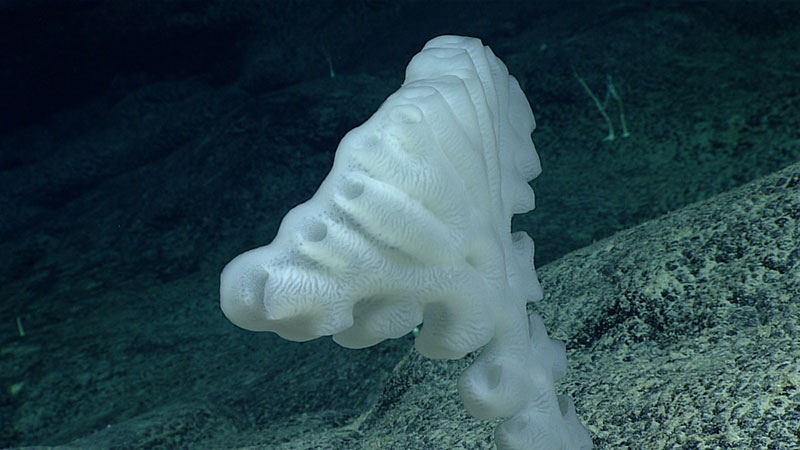
by Christopher Kelley, CAPSTONE Science Advisor/ Biology Co-Lead, University of Hawaii at Manoa
July 18, 2017

Figure 1: Tubular sponge collected during Dive 06 of the current expedition. Image courtesy of the NOAA Office of Ocean Exploration and Research, 2017 Laulima O Ka Moana. Download larger version (jpg, 807 KB).
While watching the NOAA Ship Okeanos Explorer live video stream, have you wondered about the difficulty of determining any of the species? Many deep-sea animals are very difficult to identify without having collected at least one specimen, preferably more, that can be examined carefully in the lab. This is because the taxonomy of many of these animals is based on internal morphology, such as the mesenteries (a fold of tissue that attaches organs to the body wall) inside anemones or the microscopic skeletal parts of corals (sclerites) and sponges (spicules). We usually can’t see these structures in remotely operated vehicle (ROV) video or still images, so collecting a specimen and examining it closely is the only way to “ground truth” its appearance on video.
Sometimes we come across a very distinctive animal that we can easily recognize if we see it again, but we haven’t had a chance to collect it. So we guess and sometimes those guesses can persist for many years, even decades, without us ever knowing if we are right or not.

Figure 2: Close-up of the tubular sponge showing the retracted polyps of a commensal cnidarian (yellow spots in branches). Image courtesy of the NOAA Office of Ocean Exploration and Research, 2017 Laulima O Ka Moana. Download larger version (jpg, 208 KB).
A different case is when animals, particularly sponges, were collected in trawls many years ago, but came up in many small pieces. In this case, the microscopic parts were examined, the species was described on that basis, but what the sponge actually looks like in its natural environment on ROV video is completely unknown. So we are forced to guess again, this time in regards to what we think the whole intact animal actually looks like.
A couple of cases like this have come up on this expedition, giving us the opportunity to finally solve some old mysteries. In the first case, a very distinctive sponge was encountered during a Pisces submersible dive almost 20 years ago off the Hawaiian Islands. It was never seen again after hundreds of submersible and ROV dives over the years by the University of Hawaii. Back then, we guessed that this sponge was in the class Calcarea based on its distinctive tubular morphology. We went as far as going to the genus Clathrina in databases and in the Hawaii Undersea Research Laboratory’s online deepwater animal guide . It had to be, or so we thought, from the description of that genus having distinctive anastomosing (fused together in a vein-like network) tubes.
Well, after all these years, we encountered the sponge again during Dive 06, and finally had a chance to grab a specimen and examine it under the microscope (Figure 1).
All I can say is — boy, were we wrong! To my complete surprise, the microscope revealed it was a glass sponge (Hexactinellida), not a calcarean sponge at all. We weren’t even close on what general type of sponge it was just from the video image (can you see how red my face is?). We think for now, until we get back on shore, that it is in the family Tretodictyidae. This time, we are backed up by examination of its microscopic spicules.
We also discovered that the tube-like branches had many commensal hexacorals (anemones or zoanthids) growing through the walls (Figure 2). That is something rarely observed and never described before in this family to our knowledge, so it is likely that this is a completely new species or genus. This time however, we are going to be a bit more cautious, so we aren’t saying much more than that at this point.

Figure 3: The turbocharger glass sponge collected during Dive 05 of the current expedition. Image courtesy of the NOAA Office of Ocean Exploration and Research, 2017 Laulima O Ka Moana. Download larger version (jpg, 739 KB).
The second case is what we are calling the “Turbocharger” sponge due to its distinctive tubes arising all along the upper edge of the colony (Figure 3, and we thank Matt Dornback for that fun moniker). This glass sponge has been seen a number of times during previous cruises and is shown in the Okeanos Deepwater Benthic Animal Guide as possibly being in the family Auloplacidae.
While we were less cocksure about going to genus this time, we did suggest it could be in the genus Auloplax, fortunately putting a question mark next to that. During Dive 05 at "Sally" Seamount, we came across a colony (Figure 2), quickly putting it in the box. After looking at it microscopically, I once again have to admit we were wrong (sigh).
It has a spicule called a clavule that is very distinctive and usually associated with the family Farreidae. It does not appear to be in either the family Auloplacidae or the genus Auloplax.
Oh well. We will keep trying, we will keep collecting, and we will hopefully keep getting better at this.
By exploring our deep ocean with NOAA Ship Okeanos Explorer, we are learning more about our planet every day, and we get to share that knowledge with the world. Our ocean holds mysteries more fascinating, habitats more challenging, and life forms more extraordinary than people have ever imagined. Who knows what we will find tomorrow.